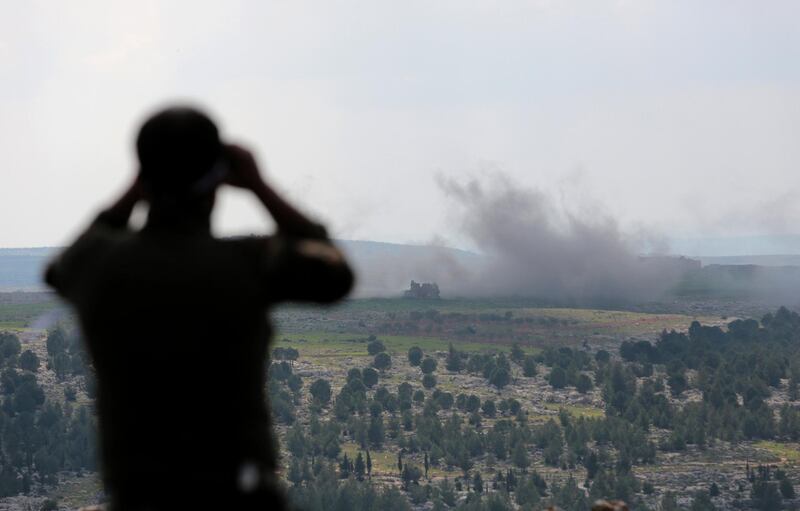A US plan to establish military observation posts in Syria near the border with Turkey is designed to prevent Ankara from launching an all-out military assault on positions held by Washington's Kurdish allies, according to experts.
However, US Secretary of Defense James Mattis is trying to cast the plan as a favour to Turkey, saying that the move is not meant to undermine Ankara's interests in the war-ravaged country.
“We are putting observation posts in several locations up along the northern Syrian border because we want to be the people who call the Turks and warn them if we see something coming out of an area that we’re operating in,” Mr Mattis said last week after his Turkish counterpart Hulusi Akar complained about the move.
The US plan does not involve adding more troops to an estimated 2500 contingent in Syria, but it would expand US military presence along the Turkish-Syrian border and could act as a buffer against attempts by Ankara to push into Kurdish-held parts of Syria's north.
Last month, the Turkish military shelled positions held by the People’s Protection Units (YPG) in the Kobane region, ahead of a planned military assault that never materialized due largely to Washington's diplomatic efforts.
Ankara is reportedly mulling a 30 km corridor and safe zones in that area, but the plan may be thwarted if the US assumed responsibility for parts of the border.
Turkey considers the YPG militia an extension of the outlawed Kurdistan Workers' Party (PKK), which has led an insurgency in Turkey for more than three decades.
The US has worked closely with the YPG in the fight against ISIS in Syria, straining relations between Washington and Ankara.
____________
Read more:
ISIS kills at least 50 SDF fighters in 72 hours, activists say
Desperate Syrians risk lives at sea escaping Lebanon
____________
“We do not say the YPG is the same as the PKK” Mr Mattis said, and a large part of the US-trained and equipped Syrian Democratic Force (SDF) is from the YPG.
Aaron Stein, a senior fellow at the Atlantic Council’s Rafik Hariri Center for the Middle East, said that the idea of border posts stems from a very real concern in Washington concerning Turkey's drive for confrontation.
“The concern in the US government about a Turkish intervention in Syria was — and remains — very real,” he said.
“Turkey is serious about its threats to move east of the river and, for many inside Turkey, it is simply a question of when to move,” Mr Stein told The National.
Hence, the observation posts, “are designed to deter Turkish action and to protect US forces and the US positions more broadly...It is a stopgap” Mr Stein argued.
The move is also an attempt by the US to refocus efforts on the battle against ISIS in Syria's east, which was temporarily derailed after Ankara intensified attacks on Kurdish positions in the north and threatened an all-out assault on YPG forces, many of whom were dispatched to areas near the Iraqi border to fight ISIS at the time.
The Syrian Democratic Forces (SDF) said this month that it is resuming the anti-ISIS campaign after intensive diplomatic efforts succeeded in diffusing tensions along the Syrian-Turkish border and allowed parties to refocus efforts on the battle against ISIS in Syria’s east.
Bassam Barabandi, a former Syrian diplomat and a co-founder of People Demand Change, said the “US wants its allies to focus on defeating ISIS…they do not want any distraction for the SDF with an understanding that a common ground between the SDF and Turkey has to be found the day after.”
In that context and until such an understanding is reached, the US observation posts would be temporary, Mr Barabandi told The National.
Inside the administration, they reflect a better working relationship between the Pentagon and the State Department where Jim Jeffrey and Joel Rayburn have taken charge of the file.
“They all agree that Turkey is an important NATO ally and that the US should work to peel it away from Russia, seek its help in defeating ISIS, and challenge Iran in Syria,” Mr Barabandi said.
Still, Nicholas Heras, a senior fellow at the Center for New American Security, said the decision could have enormous consequences for the Trump team's Syria policy.
“Establishing border posts in the areas east of the Euphrates provides a de facto shield for the SDF from Turkish assault,” Mr Heras told The National.
“These border posts are meant to signal to Turkey that the U.S. military takes its concerns about PKK attacks into Turkey from Syria seriously. But the Turks don't see it that way, they see it as building an American shield wall to prevent Turkey from creating so-called safe zones.”





